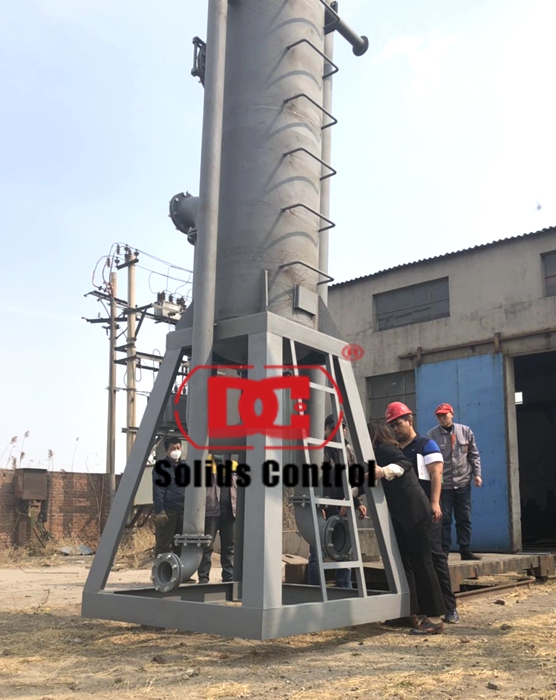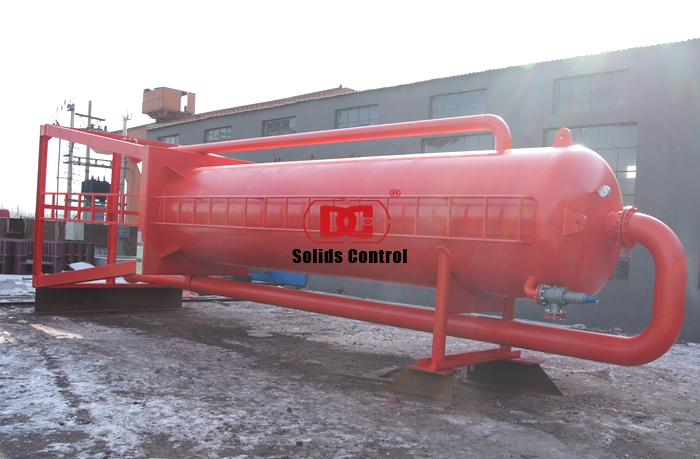A mud gas separator is special equipment for gas gutting drilling fluid primary degassing, it is an ideal mud gas separator. Mud gas separator is divided into ordinary pressure and pressure auto control is according to pressure.
The ordinary mud gas separator prevents hydration of drilling fluid and it uses excellent material manufactured, it can efficiently prevent harmful gas eroding and ensure staff and equipment are safe.
When drilling fluid produces gas cut, the proportion, and viscosity will have a big difference, it can’t meet the requirement of drilling. A mud gas separator and flare ignition device are combined and used can ensure the drilling process normal operation.

What Is Mud Gas Separator And How Does It Work?
Mud Gas Separator, located downstream of the choke manifold, is a vertical vessel used to separate any gas from drilling fluid during well control situation. Once the gas has been separated, it can pass through the vent line in the derrick. Alternatively, as long as it’s a safe distance from the rig, it could even be vented.
With mud separators, there are two main types. Also known as a ‘poor-boy’ and a ‘gas buster’, the more common of the two is called an atmospheric mud/gas separator. However, some mud/gas separators are designed to operate at moderate back pressure. Although these will mostly operate under 100 psig, it’s possible to come across those that work at the atmospheric gas vent line pressure plus the vent line friction drop.
As long as they have a liquid level control, all separators can be referred to as pressurized mud/gas separators. Ultimately, there are benefits and drawbacks to both pressurized and atmospheric mud/gas separators. Despite the differences, both types also have some common requirements. For example, the capacity of the separator may sometimes be exceeded, or a malfunction may be experienced. With this in mind, both must have a by-pass line to the flare stack as a precaution.
When the drilling fluid impinges on the vessel’s wall, certain precautions should also be taken to prevent erosion. In the case of plugging, easy cleanup should be possible with lines and vessels and these are more provisions to consider. For well testing operations, the rig mud/gas separator isn’t recommended for use unless it has been specifically designed for use in these conditions.
When a kick is being displaced, the mud/gas separator should be lined up constantly. As well as removing large gas bubbles from mud, the separator is also used to cope with gas flows as the influx reaches the surface.
Often, there are questions regarding the volume of gas with which each separator can safely cope. There will be a limit, and there’s a danger of gas getting into the shaker header box if this limit is breached. When it comes to calculating the maximum gas flow rate for each separator, an estimate can be made.
What Factors Will Limit This Flow Rate?
Mainly, this will come from the relationship between the hydrostatic head of fluid located at the mud outlet and the backpressure at the outlet to the vent line. At times, there’s a risk the backpressure at the gas flow will be greater than (or even equal to) the mud outlet’s available hydrostatic head. When this occurs, the shaker head tank may be in danger.
At all times, minimizing risk should be a key objective and this can be aided with a large ID and straight vent line. Elsewhere, the mud outlet should be set up with a hydrostatic head of at least ten feet.
Furthermore, it’s important to keep an eye on the pressure gauge used for backpressure. If registered readings are showing pressure close to the discharge line’s hydrostatic head, this is a warning of a so-called ‘blow-through’. When large amounts of condensate or oil are displaced to the surface, the maximum hydrostatic head may not be equal to that of mud.
When the separator is in danger of breaching the safe operating limit, check that the well isn’t over-pressured and close in the choke. Alternatively, switch the flow to the burn pit or overboard line.
Application Rang of Mud Gas Separator
Mud gas separator is matching used with throttle manifold, it can break away the free gas in drilling fluid. It can be used to dispose underbalance drilling and hydrothion drilling fluid.
Separates free gas accumulations, including toxic gases such as hydrogen sulfide, from the drilling mud system.
Reduces Hazardous Gas Threat – The separated gas is carried by vent lines to a remote location and flared.
Fail-safe gas delivery can be controlled by a back-pressure manifold valve in the flare line.
Versatile Configuration – Designed such that it can be raised or lowered for flow line adjustments to minimize piping.

DC solid control is according research of at home and abroad, our engineer combine with technology develop a new type mud gas separator, it not only has all features of common mud gas separator but also has long service life. It can meet the requirements of customers’ and the mud gas separator is popular in Middle –east, America, Asian, and other districts.
 Linear Motion Shale Shaker In Drilling Rig
Linear Motion Shale Shaker In Drilling Rig  Oilfield Mud Cleaner
Oilfield Mud Cleaner  Drilling Fluid Decanter Centrifuge
Drilling Fluid Decanter Centrifuge  Drilling Mud Desander
Drilling Mud Desander  Hydrocyclone Desilter
Hydrocyclone Desilter  Centrifugal Pump/Centrifugal Mud Pump
Centrifugal Pump/Centrifugal Mud Pump  Shear Pump
Shear Pump  Jet Mud Mixer
Jet Mud Mixer  Horizontal Mud Agitator
Horizontal Mud Agitator  Constant Pressure Drilling Fluid Mud Gas Separator
Constant Pressure Drilling Fluid Mud Gas Separator  Mud Gun
Mud Gun  Mud Tank
Mud Tank  Solids Control System Vacuum Degasser
Solids Control System Vacuum Degasser  Flare Ignition Device
Flare Ignition Device  Diesel Tank
Diesel Tank  Submersible Slurry Pump
Submersible Slurry Pump 






































